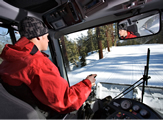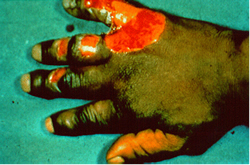
 |
|||
NIOSH Safety and Health Topic:Cold Stress |
|



Photos courtesy of U.S. Fish and Wildlife Service
Workers who are exposed to extreme cold or work in cold environments may be at risk of cold stress. Extreme cold weather is a dangerous situation that can bring on health emergencies in susceptible people, such as those without shelter, outdoor workers, and those who work in an area that is poorly insulated or without heat. What constitutes cold stress and its effects can vary across different areas of the country. In regions relatively unaccustomed to winter weather, near freezing temperatures are considered factors for "cold stress." Whenever temperatures drop decidedly below normal and as wind speed increases, heat can more rapidly leave your body. These weather-related conditions may lead to serious health problems.
Hypothermia | Frostbite | Trench Foot | Chilblains
When exposed to cold temperatures, your body begins to lose heat faster than it can be produced. Prolonged exposure to cold will eventually use up your body's stored energy. The result is hypothermia, or abnormally low body temperature. A body temperature that is too low affects the brain, making the victim unable to think clearly or move well. This makes hypothermia particularly dangerous because a person may not know it is happening and will not be able to do anything about it.
Symptoms of hypothermia can vary depending on how long you have been exposed to the cold temperatures.
Take the following steps to treat a worker with hypothermia:
 Frostbite is an injury to the body that is caused by freezing. Frostbite causes a loss of feeling and color in the affected areas. It most often affects the nose, ears, cheeks, chin, fingers, or toes. Frostbite can permanently damage body tissues, and severe cases can lead to amputation. In extremely cold temperatures, the risk of frostbite is increased in workers with reduced blood circulation and among workers who are not dressed properly.
Frostbite is an injury to the body that is caused by freezing. Frostbite causes a loss of feeling and color in the affected areas. It most often affects the nose, ears, cheeks, chin, fingers, or toes. Frostbite can permanently damage body tissues, and severe cases can lead to amputation. In extremely cold temperatures, the risk of frostbite is increased in workers with reduced blood circulation and among workers who are not dressed properly.
Symptoms of frostbite include:
Workers suffering from frostbite should:
Trench foot, also known as immersion foot, is an injury of the feet resulting from prolonged exposure to wet and cold conditions. Trench foot can occur at temperatures as high as 60 degrees F if the feet are constantly wet. Injury occurs because wet feet lose heat 25-times faster than dry feet. Therefore, to prevent heat loss, the body constricts blood vessels to shut down circulation in the feet. Skin tissue begins to die because of lack of oxygen and nutrients and due to the buildup of toxic products.
Symptoms of trench foot include:
Workers suffering from trench foot should:
Chilblains are caused by the repeated exposure of skin to temperatures just above freezing to as high as 60 degrees F. The cold exposure causes damage to the capillary beds (groups of small blood vessels) in the skin. This damage is permanent and the redness and itching will return with additional exposure. The redness and itching typically occurs on cheeks, ears, fingers, and toes.
Symptoms of chilblains include:
Workers suffering from chilblains should:
Employers should take the following steps to protect workers from cold stress:
Workers should avoid exposure to extremely cold temperatures when possible. When cold environments or temperatures can not be avoided, workers should follow these recommendations to protect themselves from cold stress:
CDC: Extreme Cold - A Prevention Guide to Promote Your Personal Health and Safety
Information on how to prepare indoors and outdoors fore extreme cold.
![]() 3.45 MB (15 pages)
3.45 MB (15 pages)
Occupational Safety & Health Administration (OSHA): Tips to Protect Workers in Cold Environments
External link: http://www.osha.gov/html/cold_protection_2004.html
OSHA: Sawmill eTool: Cold Stresses
Cold stress hazards, solutions, and controls.
External link: http://www.osha.gov/SLTC/etools/sawmills/cold.html
OSHA: The Cold Stress Equation
Information on frostbite and hypothermia.
External link: http://www.osha.gov/Publications/coldcard/coldcard.html
National Oceanic and Atmospheric Administration (NOAA): Winter Storms - A Preparedness Guide
This preparedness guide explains the dangers of winter weather and suggests life-saving action you can take. With this information, you can recognize winter weather threats, develop an action plan and be ready when severe winter weather threatens.![]() 2.15 MB (12 pages)
2.15 MB (12 pages)
NOAA: National Weather Service Wind Chill Chart
External link: http://www.weather.gov/om/windchill/index.shtml
American Conference of Governmental Industrial Hygienists: Product Store - Threshold Limit Values and Biological Exposure Indices
This document is available for purchase at: http://www.acgih.org/store/ProductDetail.cfm?id=1360
American National Standards Institute - Ergonomics of the Thermal Environment: Medical Supervision of Individuals Exposed to Extreme Hot or Cold Environments
This International Standard provides advice to those concerned with the safety of human exposures to extreme hot or cold thermal environments.
This document is available for purchase at: http://webstore.ansi.org/RecordDetail.aspx?sku=ISO+12894%3a2001
Alaska Department of Labor and Workforce Development: Labor Standards and Safety - Cold Stress
Physical agent data sheets on hypothermia and frostbite.![]() 149.34 KB (7 pages)
149.34 KB (7 pages)
Occupational Hazards.com: Don't Leave Safety Out in the Cold
Information on cold stress symptoms and PPE.
External link: http://www.occupationalhazards.com/Issue/Article/76091/Dont_Leave_Safety_Out_in_the_Cold.aspx
Canadian Centre for Occupational Health & Safety: Cold Weather Workers Safety Guide
Cold weather safety, including PPE.![]() 123.65 KB (8 pages)
123.65 KB (8 pages)